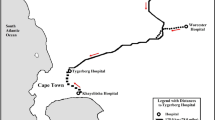Abstract
Background and aims
Since 1999, the Dutch trauma care has been regionalized into ten trauma systems. This study is the first to review such a trauma system. The aim was to examine the sensitivity of prehospital triage criteria [triage revised trauma score (T-RTS)] in identifying major trauma patients and to evaluate the current level of trauma care of a regionalized Dutch trauma system for major trauma patients.
Patients and methods
Major trauma patients (n=511) (June 2001–December 2003) were selected from a regional trauma registry database. The prehospital T-RTS was computed and standardized W scores (Ws) were generated to compare observed vs expected survival based on contemporary US- and UK-norm databases.
Results
The T-RTS showed low sensitivity for the prehospital identification of major trauma patients [34.1% (T-RTS≤10)]. Nevertheless, 78.0% of all major trauma patients were directly managed by the trauma center. These patients were more severely injured than their counterparts at non-trauma-center hospitals (p<0.001). No significant difference emerged between the mortality rates of both groups. The Ws {−0.46 calculated on the US model [95% confidence interval (CI) ranging from −1.99 to 1.07]} [0.60 calculated on the UK model (95% CI ranging from −1.25 to 2.44)] did not differ significantly from zero.
Conclusion
The trauma center managed most of the major trauma patients in the trauma system but the triage criteria need to be reconsidered. The level of care of the regional trauma system was shown to measure up to US and UK benchmarks.

Similar content being viewed by others
References
Gwinnutt CL, Driscoll PA, Whittaker J (2001) Trauma systems — state of the art. Resuscitation 48:17–23
MacKenzie EJ, Hoyt DB, Sacra JC, Jurkovich GJ, Carlini AR, Teitelbaum SD, Teter H Jr (2003) National inventory of hospital trauma centers. JAMA 289:1515–1522
Westhoff J, Hildebrand F, Grotz M, Richter M, Pape HC, Krettek C (2003) Trauma care in Germany. Injury 34:674–683
Nathens AB, Brunet FP, Maier RV (2004) Development of trauma systems and effect on outcomes after injury. Lancet 363:1794–1801
West JG, Williams MJ, Trunkey DD, Wolferth CC Jr (1988) Trauma systems. Current status — future challenges. JAMA 259:3597–3600
Jurkovich GJ, Mock C (1999) Systematic review of trauma system effectiveness based on registry comparisons. J Trauma 47:S46–S55
American Association for the Advancement of Automotive Medicine (1998) The abbreviated injury scale, 1990 revision (update 1998). American Association for the Advancement of Automotive Medicine, Barrington
Baker SP, O’Neill B, Haddon W Jr, Long WB (1974) The injury severity score: a method for describing patients with multiple injuries and evaluating emergency care. J Trauma 14:187–196
Champion HR, Sacco WJ, Copes WS, Gann DS, Gennarelli TA, Flanagan ME (1989) A revision of the Trauma Score. J Trauma 29:623–629
Subcommiteee on Trauma Registry Programs, American College of Surgeons Committee on Trauma (2004) National Trauma Data Bank: reference manual: background, caveats, and resources (NTDB version 4.0)
Hollis S, Yates DW, Woodford M, Foster P (1995) Standardized comparison of performance indicators in trauma: a new approach to case-mix variation. J Trauma 38:763–766
Colton C (ed) (2003) World trauma care systems. Injury 34:643–744(special issue)
Committee on Trauma, American College of Surgeons (1998) Resources for optimal care of the injured patient: 1999. American College of Surgeons, Chicago
Gabbe BJ, Cameron PA, Finch CF (2003) Is the revised trauma score still useful? ANZ J Surg 73:944–948
Baxt WG, Berry CC, Epperson MD, Scalzitti V (1989) The failure of prehospital trauma prediction rules to classify trauma patients accurately. Ann Emerg Med 18:1–8
Roorda J, van Beeck EF, Stapert JW, ten Wolde W (1996) Evaluating performance of the revised trauma score as a triage instrument in the prehospital setting. Injury 27:163–167
Copes WS, Champion HR, Sacco WJ, Lawnick MM, Keast SL, Bain LW (1988) The injury severity score revisited. J Trauma 28:69–77
MacKenzie EJ, Rivara FP, Jurkovich GJ, Nathens AB, Frey KP, Egleston BL, Salkever DS, Scharfstein DO (2006) A national evaluation of the effect of trauma-center care on mortality. N Engl J Med 26:366–378
Jones JM, Redmond AD, Templeton J (1995) Uses and abuses of statistical models for evaluating trauma care. J Trauma 38:89–93
Champion HR, Sacco WJ, Copes WS (1995) Injury severity scoring again. J Trauma 38:94–95
Younge PA, Coats TJ, Gurney D, Kirk CJ (1997) Interpretation of the Ws statistic: application to an integrated trauma system. J Trauma 43:511–515
Taheri PA, Butz DA, Greenfield LJ (2000) Length of stay has minimal impact on the cost of hospital admission. J Am Coll Surg 191:123–130
Schmelz A, Ziegler D, Beck A, Kinzl L, Gebhard F (2002) Costs for acute, stationary treatment of polytraumapatients. Unfallchirurg 105:1043–1048
Zoltie N, de Dombal FT (1993) The hit and miss of ISS and TRISS. Yorkshire Trauma Audit Group. BMJ 307:906–909
Acknowledgements
We would like to thank Mr. D.E. Clark and Mr. O. Bouamra for providing us, respectively, with the NTDB and TARN population distributions of the Ps for the calculation of the Ws statistics for our study. The following hospitals have contributed data to the regional trauma registry of the TCWN (the trauma surgeons acting as coordinators for the trauma registry at the respective hospitals are in parentheses): Leiden University Medical Center, Leiden (G.N. Jukema, M.D., Ph.D.); The Hague Medical Center, The Hague (M. Hogervorst, M.D.); Hospital Leyenburg, The Hague (P.V.M. Pahlplatz, M.D.); Bronovo Hospital, The Hague (A.H.P. Niggebrugge, M.D., Ph.D.); Juliana Children’s Hospital, The Hague (J.H. Allema, M.D., Ph.D.); Red Cross Hospital, The Hague (J.H. Allema, M.D., Ph.D.); Rijnland Hospital, Leiderdorp (A.J. den Outer, M.D.); Diaconessen Hospital, Leiden (B.J. Hornstra, M.D.); ’t Lange Land Hospital, Zoetermeer (L.J.J.P. Speetjens, M.D.); Reinier de Graaf Hospital, Delft (M. van der Elst, M.D., Ph.D.)
Author information
Authors and Affiliations
Corresponding author
Rights and permissions
About this article
Cite this article
Sturms, L.M., Hoogeveen, J.M., Le Cessie, S. et al. Prehospital triage and survival of major trauma patients in a Dutch regional trauma system: relevance of trauma registry. Langenbecks Arch Surg 391, 343–349 (2006). https://doi.org/10.1007/s00423-006-0057-1
Received:
Accepted:
Published:
Issue Date:
DOI: https://doi.org/10.1007/s00423-006-0057-1




